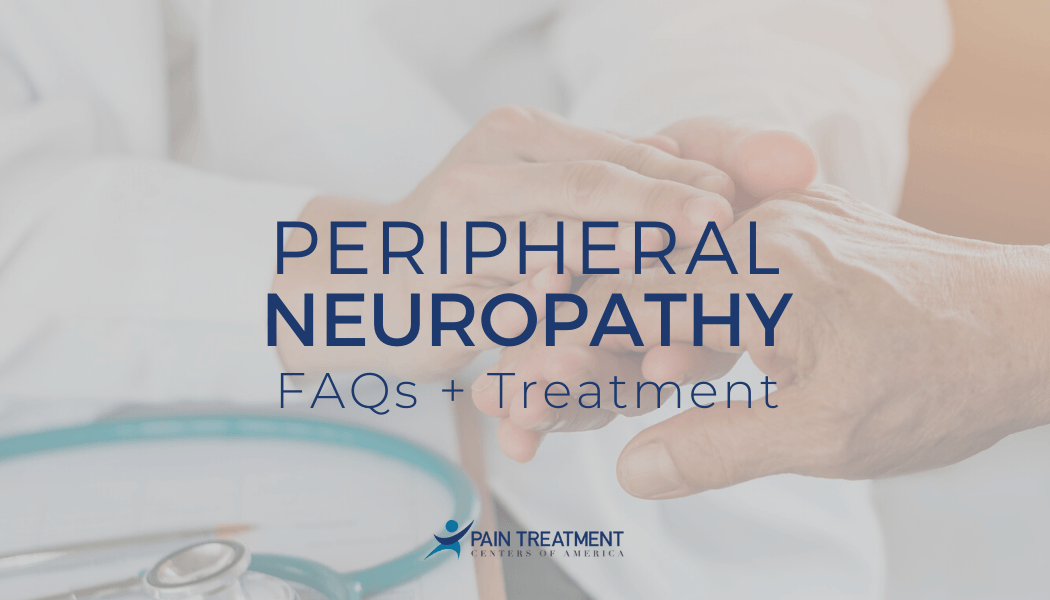Peripheral Neuropathy Info and Treatment
The peripheral nervous system encompasses a vast network of motor and sensory nerves. These nerves connect the brain and spinal cord to the rest of the body and control complex functions like movement, sensation, breathing, bladder control and motor function.
When the peripheral nerves are damaged by injury or disease, it can lead to a condition known as peripheral neuropathy .
Here’s what you should know about this condition, including symptoms and treatment.
Different Types of Peripheral Neuropathy
There are two main types of peripheral neuropathy: mononeuropathy (including multiple mononeuropathy) and polyneuropathy .
Mononeuropathy affects only a single peripheral nerve, while polyneuropathy affects multiple nerves. Multiple mononeuropathy can affect single nerves in different areas of the body.
What Causes Peripheral Neuropathy?
Physical injury is the leading cause of peripheral mononeuropathy in the United States . Carpal tunnel syndrome, the most common form, is caused by trauma to the median nerve in the wrist. Car accidents, serious falls and sports injuries can also cause physical trauma that leads to mononeuropathy.
Polyneuropathy, which affects multiple nerve cells, is commonly caused by acquired diseases.
Diabetes is the leading cause of polyneuropathy in the United States. Diabetic neuropathy occurs when chronic high levels of blood sugar attack the nerves throughout the body. Up to 70% of people with diabetes have some form of this condition.
Other common causes of neuropathy include:
- Systemic Auto-Immune Diseases. Sjogren’s Syndrome, lupus, and rheumatoid arthritis can cause the body’s own immune system to attack nerve cells throughout the body, leading to neuropathy.
- Infections. Viruses like herpes simplex, HIV, the varicella-zoster virus and West Nile virus can attack nerve tissues which can then lead to neuropathic symptoms.
- Alcohol. Excessive alcohol consumption can be damaging to nerve tissue in various parts of the body.
- Exposure to Toxins. Toxic neuropathy can occur with exposure to certain chemicals and toxins, such as mercury, lead, brevetoxin, and hexacarbons, among others.
- Nutritional Imbalances. Malnutrition and vitamin deficiencies, particularly a lack of Vitamin B12 , have been linked to peripheral neuropathy.
- Cancer Treatment. Cancer treatments like chemotherapy can damage the peripheral nerves.
- Genetics. Inherited neuropathy is passed from parent to child and may be diagnosed early in life. Charcot-Marie-Tooth Disease is the most common inherited neuropathy, although genetic neuropathy overall is extremely rare.
What Are The Symptoms of Peripheral Neuropathy?
Motor, sensory and autonomic nerve damage are the hallmarks of peripheral neuropathy.
Damage to motor and sensory nerves can lead to a host of symptoms:
- Numbness, prickling, and tingling in the hands and feet
- Stabbing or burning pain
- Extreme sensitivity to touch
- Muscle weakness
- A feeling of wearing an “invisible” sock or glove
- Inexplicable pain in arms, legs, hands or feet
- Lack of coordination
- Muscle weakness
Autonomic neuropathy can cause the following symptoms:
- Excessive sweating
- Bladder, bowel and digestive issues
- Dizziness
- Sudden changes in blood pressure
- Lightheadedness or faintness
How is Peripheral Neuropathy Diagnosed?
Your doctor will begin by taking a full medical history and performing physical and neurological examinations.
Additional diagnostic tests may include:
- Blood tests - Typically, these tests check for levels of Vitamin B12, thyroid and kidney function, and immune function, among other things.
- Nerve function tests - Electromyography and nerve conduction tests measure nerve health and function.
- Nerve and skin biopsies can check nerve endings
- Imaging tests - CT scans and MRIs can check for abnormalities in the skeleton or muscles.
Because every individual’s symptoms are different, your doctor may recommend other tests in addition to these.
How Is Peripheral Neuropathy Treated?
Peripheral neuropathy pain and muscle weakness can be debilitating. For many people, the condition has a negative impact on work, family life and personal goals.
It’s important for individuals with this condition to find effective pain management options, so they can get back to living their lives.
While there is no cure for neuropathy, there are treatments available to decrease pain, strengthen muscles and improve coordination:
- Physical therapy
- Traditional medicines used to control pain
- Anti-seizure medications
- Antidepressants
- Therapeutic nerve blocks
- Topical medications like pain-relieving creams
Explore treatment options with a pain management provider you trust.
Peripheral Neuropathy Treatment at Pain Treatment Centers of America
At PTCOA, we’re proud to offer treatment for a range of pain conditions, including peripheral neuropathy.
We specialize in a number of treatment options for neuropathic pain, including physical therapy, nerve blocks, and traditional pain treatments.
Contact us today to learn more or to schedule your appointment: (844) 215-0731.














